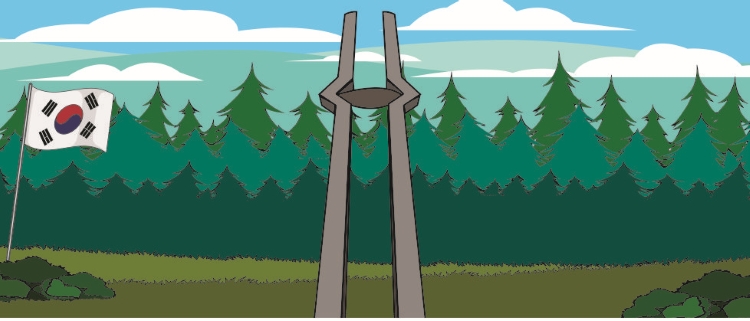

▲ National Cemetery for the May 18 Gwangju Democratization Uprising
Historical Background
The May 18 Gwangju Democratization Uprising demanded the abolition of martial law, the resignation of the Defense of Security Commander Doohwan Chun and other officials of the military, and the release of president Daejung Kim, who had been put on military trial on charges of plotting civil war and causing the May 18 Gwangju Democratization Uprising.
The uprising began in October, 1979, with a series of incidents in which president Chunghee Park's long-term military dictatorship lost its ability to govern. On October 4, when Youngsam Kim, president of the New Democratic Party, was expelled from the National Assembly, the Buma uprising broke out in Busan and Masan from October 15 to October 20. Jaegyu Kim killed Chunghee Park on October 26 due to a conflict over how to resolve the uprising. In the process of recovery of the October 26 incident, the new military forces under the Defense of Security Commander Doohwan Chun emerged and had took control through the December 12 mutiny.
On February 29, 1980, Daejung Kim and others were reinstated, but in the spring of that year, the new military was building a power base by making Kyuhah Choi's interim government nominal and refusing to present democracy on a political schedule demanded by the people. The public resistance to the military's desire to retain Kyuha Choi as president was expressed in various ways centering on the student movement. It spread to protests demanding the abolition of martial law in 37 universities in several cities, including Seoul, Busan, Daegu, and Gwangju, from May 13 to May 14.
On May 15, student movements, such as protests at Seoul Station, continued into the night, almost paralyzing the cities and threatening the new military forces. On May 16, student representatives from 24 universities seemed to enter a lull as they decided to stop street protests. On May 17, the leaders of the student movement were arrested when the emergency martial law, which was controlled by the new military forces, announced measures to expand it nationwide. Under these conditions, the Gwangju Democratization Uprising began on May 18.
Process
Inspired by the May 13 protests for democracy in Seoul, students in Gwangju protested on 14 and 15, and torchlight demonstrations took place at night in Gwangju on May 16. At around 1:00 PM on May 18, army warfare commands were deployed to Gwangju and army troops entered each university. Students gathered in front of Chonnam National University in accordance with the resolution to gather in front of the school gate if the school was closed. The military stopped this demonstration, so students gathered again at Gwangju Station. Militaries began to suppress protests in the city, resulting in a series of injuries. Citizens were shocked when soldiers committed atrocities such as beating and trampling young people and women who appeared to be students in downtown areas. The army's excessive armed suppression succeeded in dispersing the protest, but also united the citizens, providing an opportunity for civic and student solidarity to occur on May 19.
On May 20, taxi and bus drivers gathered at Gwangju Station and Mudeung Stadium and these demonstrations were able to drive out the troops. Then, the army warfare commands fired against the crowds around 11:00 PM and even urban poor and workers began to participate in the protest from May 20. Later, there was an armed struggle between the army and citizens who had seized weapons to counter it. The battle between them resulted in the most deaths and injuries.
Result
Through the May 18 Gwangju Democratization Uprising, the Republic of Korea developed into a democracy. In addition, on December 21, 1995, president Youngsam Kim legislated the May 18 Special Act, and responded to the demands of the people with the slogan of "Correcting History."
The May 18 Democroatic Uprising was an act of righteous resistance to protect the survival and human rights against the violence of the new military regime. Also, it is of great value in that it was able to protect democracy in Korean society and reminds us why human rights and democracy are precious.
Reporter,
Minju Kim alswn020716@g.seoultech.ac.kr


 Comment 0
Comment 0 Posts containing profanity or personal attacks will be deleted
Posts containing profanity or personal attacks will be deleted